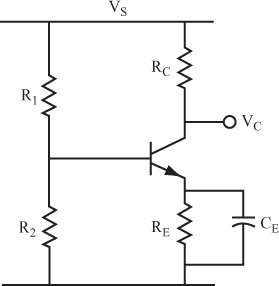Analyzing an Amplifier
28 Up to now, the emphasis has been on designing a simple amplifier and an emitter follower. This section shows how to “analyze” a circuit that has already been designed. In this case, to “analyze” means to calculate the collector DC voltage (the bias point) and find the AC gain. This procedure is basically the reverse of the design procedure.
Start with the circuit shown in Figure 8.27.
Following are the steps you use to analyze a circuit:

When you use the second formula, you must find the value of Rin (or hie) on the data sheets for the transistor from the manufacturer.
Use the circuit shown in Figure 8.28 for the following questions. For these questions, use β = 100, Rin = 2 kΩ and the values given in the circuit drawing.
Calculate ...
Get Complete Electronics Self-Teaching Guide with Projects now with the O’Reilly learning platform.
O’Reilly members experience books, live events, courses curated by job role, and more from O’Reilly and nearly 200 top publishers.


